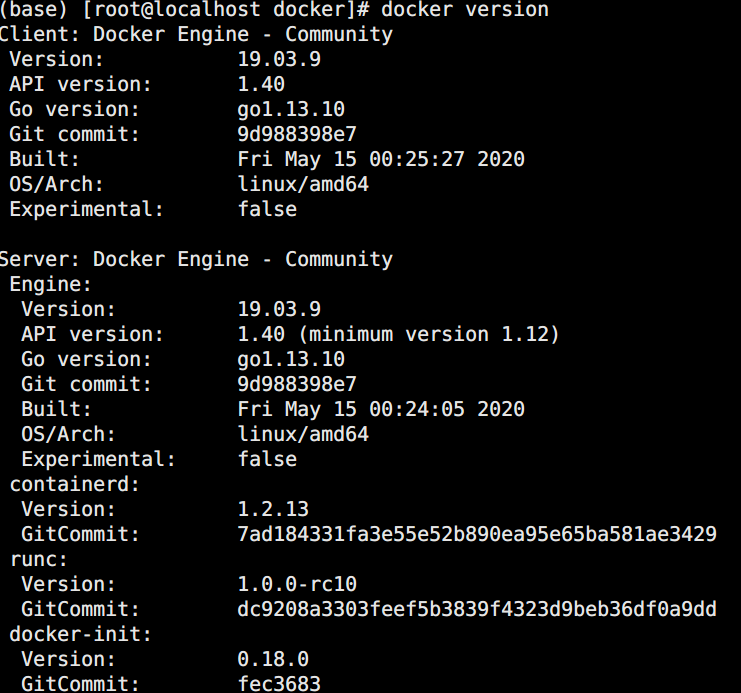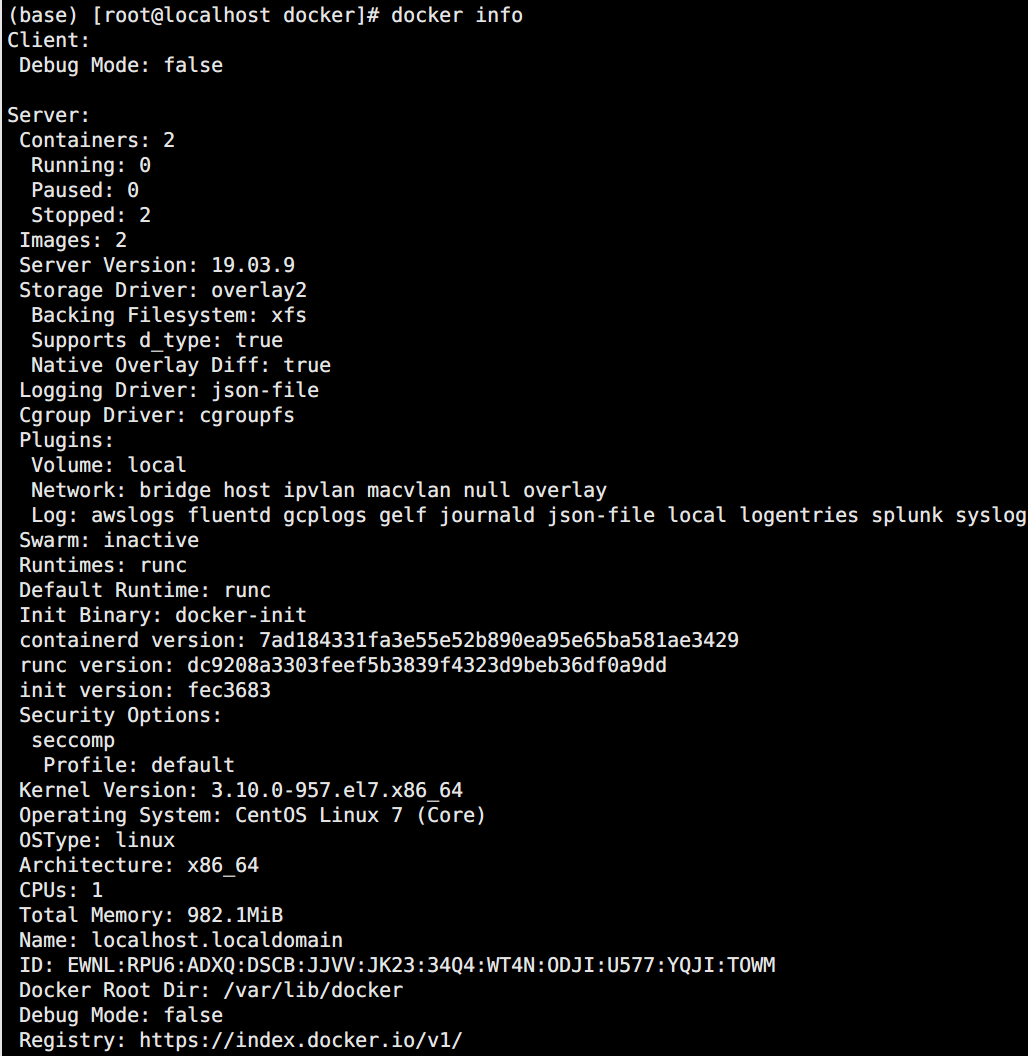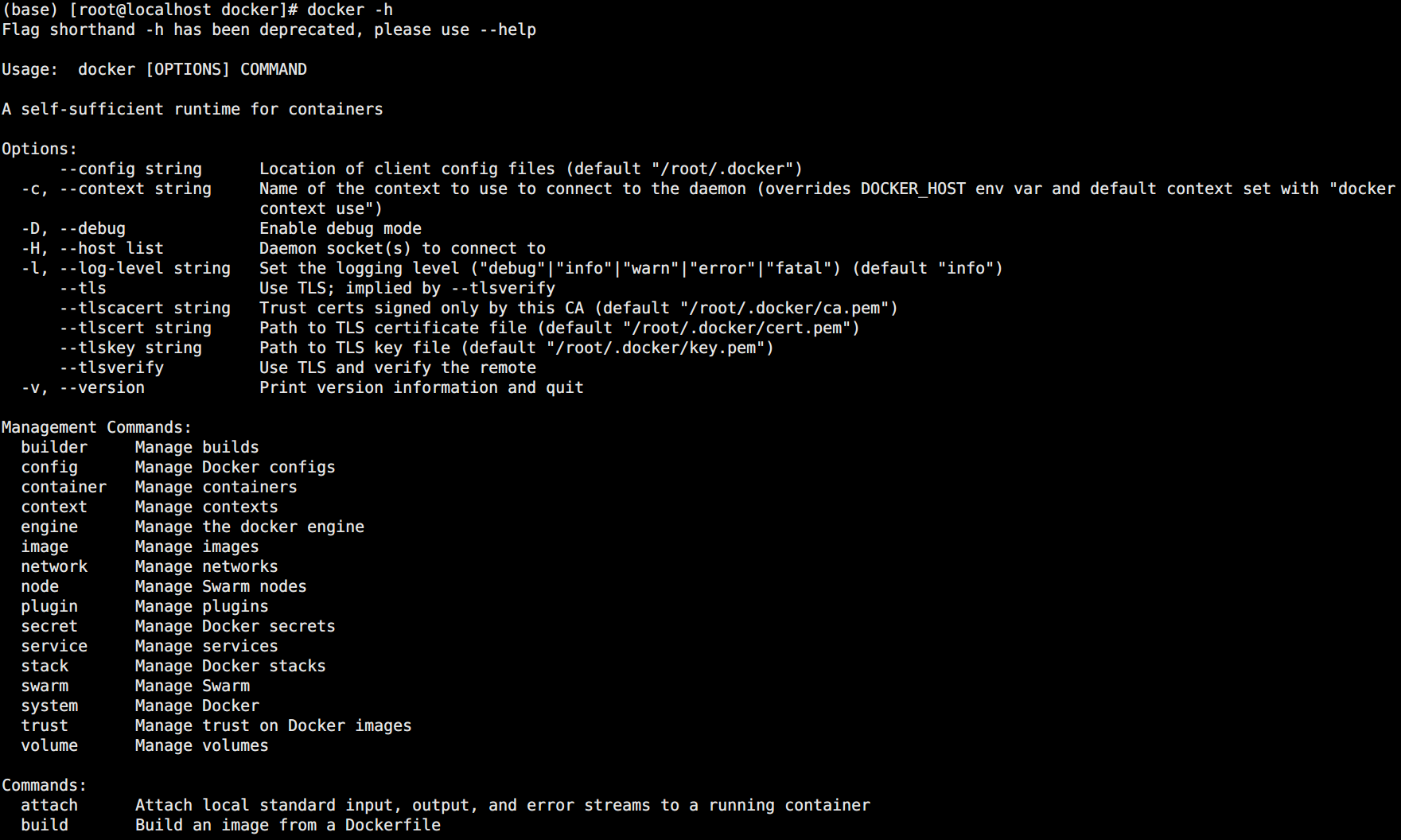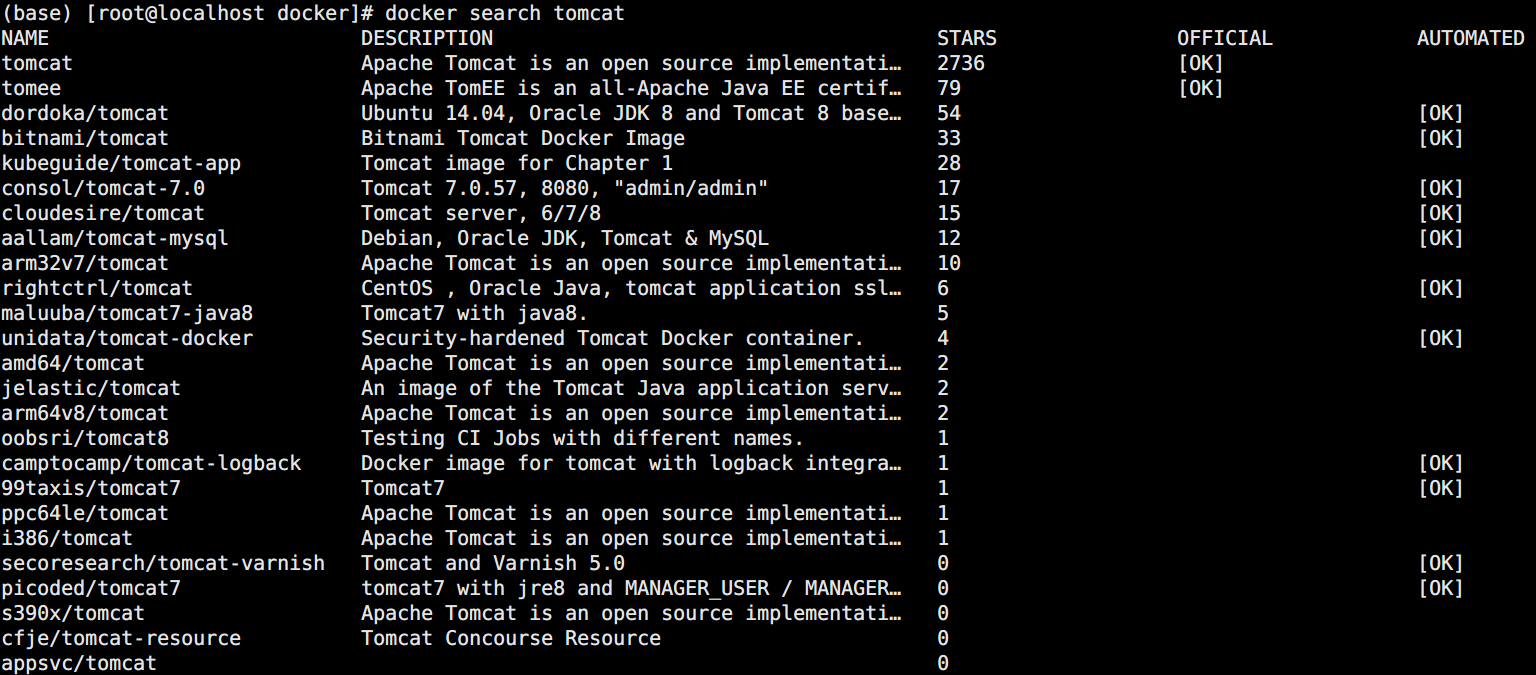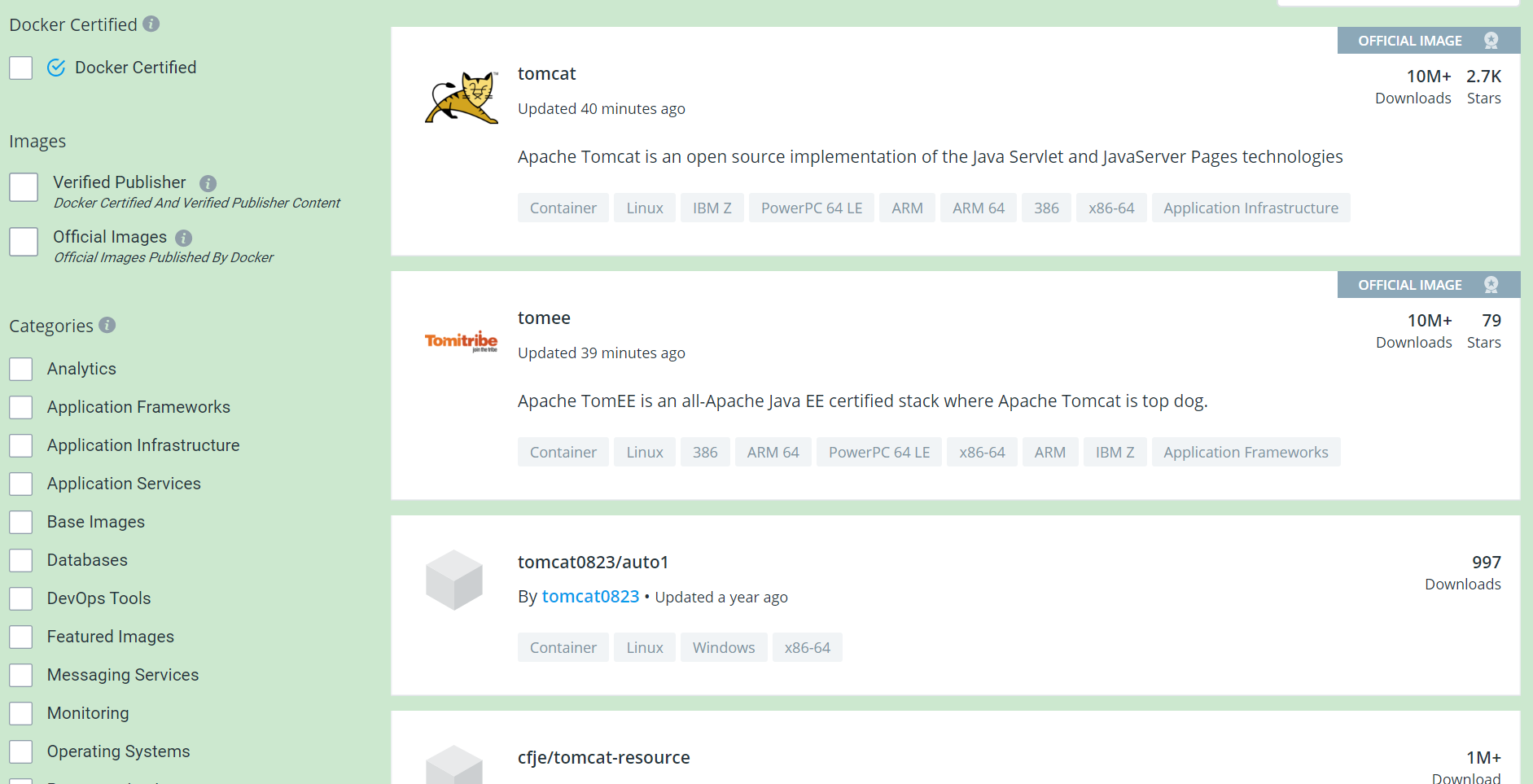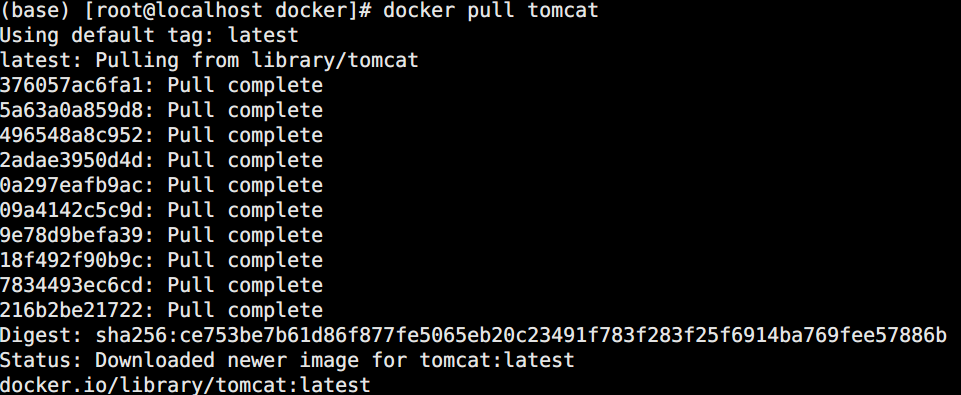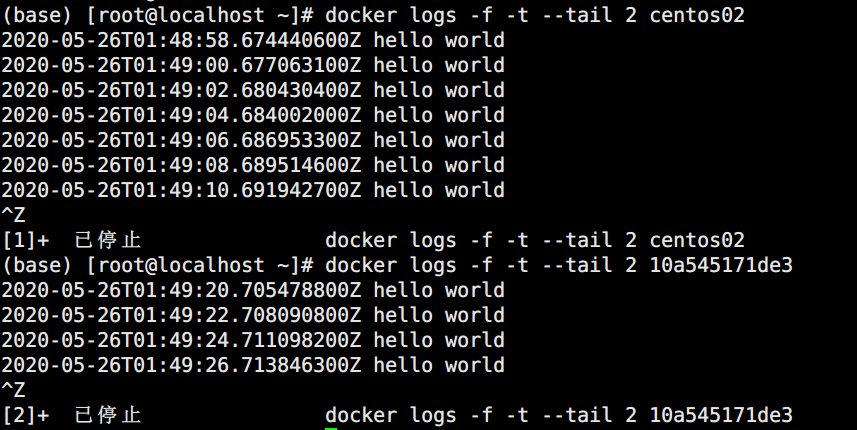Docker 常用命令
1. 帮助命令
-
docker version
-
docker info
-
docker --help(-h)
2. 镜像命令
-
docker images 列出本地主机上的镜像
-
REPOSITORY:表示镜像的仓库源
-
TAG:镜像的标签
-
IMAGE ID:镜像ID
-
CREATED:镜像创建时间
-
SIZE:镜像大小
同一仓库源可以有多个 TAG,代表这个仓库源的不同个版本,我们使用 REPOSITORY:TAG 来定义不同的镜像。 如果你不指定一个镜像的版本标签,例如你只使用 ubuntu,docker 将默认使用 ubuntu:latest 镜像
-
images 命令 的 option 参数
-
-a:列出本地所有的镜像(含中间映像层)
-
-q :只显示镜像ID
- --digests :显示镜像的摘要信息
- --no-trunc :显示完整的镜像信息
-
-
-
docker search 镜像名 从 Docker hub 官网搜索镜像
以 tomcat 为例
和在官网搜索的结果一模一样
-
参数说明
- -s : 列出收藏数不小于指定值的镜像
只搜索点赞数大于30的镜像
-
--no-trunc : 显示完整的镜像描述
-
--automated : 只列出 automated build类型的镜像
-
docker pull 镜像名:tag 拉取镜像(从前面我们已经设置的阿里云的镜像加速地址)
如果
docker pull 镜像名后面不加参数,默认下载最新版本即 docker pull tomcat 等价于 docker pull tomcat:latest
docker pull tomcat -
docker rmi 镜像名/镜像id 删除 Docker 镜像
ps:
docker rmi 镜像名默认会删除标签为 :latest 的镜像,如果要删除指定标签的镜像,在镜像名后面指定 tag 即可如果无法删除,出现如上提示,表示我们的镜像正在使用中,可以使用 -f 强制删除
如果想要删除多个镜像
docker rmi -f 镜像名1:tag 镜像名2:tag
sudo docker rmi -f hello-world tomcat删除全部镜像
sudo docker rmi -f $(docker images -qa)
3. 容器命令
-
以 CentOS 为例,从阿里云下载一个 CentOS 的镜像
-
新建并启动容器(以 Docker 里面的 CentOS 镜像为例)
docker run [options] image [command] [arg...]options 这里常用的有:
--name="容器新名字": 为容器指定一个名称; -d: 后台运行容器,并返回容器ID,也即启动守护式容器; -i:以交互模式运行容器,通常与 -t 同时使用; -t:为容器重新分配一个伪输入终端,通常与 -i 同时使用; -P: 随机端口映射; -p: 指定端口映射,有以下四种格式
1.ip:hostPort:containerPort 2.ip::containerPort 3.hostPort:containerPort 4.containerPort我们使用 -it 参数来启动 CentOS 容器
root@ 后面跟着的就是该容器的 id
-
查看所有运行的容器命令
docker ps [options]
参数说明:
-a :列出当前所有正在运行的容器+历史上运行过的容器 -l :显示最近运行的容器。 -n number:显示最近 number 个创建的容器。 -q :静默模式,只显示容器编号。 --no-trunc :不截断输出。
-
退出容器
exit: 容器停止并退出
ctrl+p+q: 容器不停止退出- 启动已经创建的容器
docker start 容器id/容器名- 重启容器
docker restart 容器id/容器名- 停止容器
docker stop 容器id/容器名- 强制关闭容器
docker kill 容器id/容器名- 删除已停止的容器
docker rm 容器id/容器名
一次性删除多个已经停止的容器
docker rm -f $(docker ps -qa) 或者 docker ps -a -q | xargs docker rm-
交互式容器和守护式容器
前面启动 CentOS 容器使用的 -it 参数就是表示交互式命令,通过终端来保持和容器的交互
如果要启动守护式容器,那么需要加上 -d 参数
但是此时查询正在运行的容器,没有发现以后台模式运行的 Docker 容器
发现该容器已经自动退出了
问题:docker ps -a 进行查看, 会发现容器已经退出 很重要的一点: Docker容器后台运行,就必须有一个前台进程. 容器运行的命令如果不是那些一直挂起的命令(比如运行top,tail),是会自动退出的。
这个是docker的机制问题,比如你的web容器,我们以nginx为例,正常情况下,我们配置启动服务只需要启动响应的service即可。例如 service nginx start 但是,这样做,nginx为后台进程模式运行,就导致docker前台没有运行的应用, 这样的容器后台启动后,会立即自杀因为他觉得他没事可做了. 所以,最佳的解决方案是,将你要运行的程序以前台进程的形式运行
-
容器日志
对于后台运行的容器,可以以下面的方式来启动
docker run -d --name centos02 centos /bin/sh -c "while true;do echo hello world;sleep 2;done"
即便是后台启动,但是因为前台一直打印日志,Docker 容器也不会自动关闭
如果此时我们想去查看 Docker 容器的日志,可以通过以下命令
docker logs -f -t --tail 容器ID/容器名-
-t 是加入时间戳
-
-f 跟随最新的日志打印
-
--tail 数字 显示最后多少条
- 查看容器内运行的进程
docker top 容器ID/容器名
- 查看容器内部细节
docker inspect 容器ID/容器名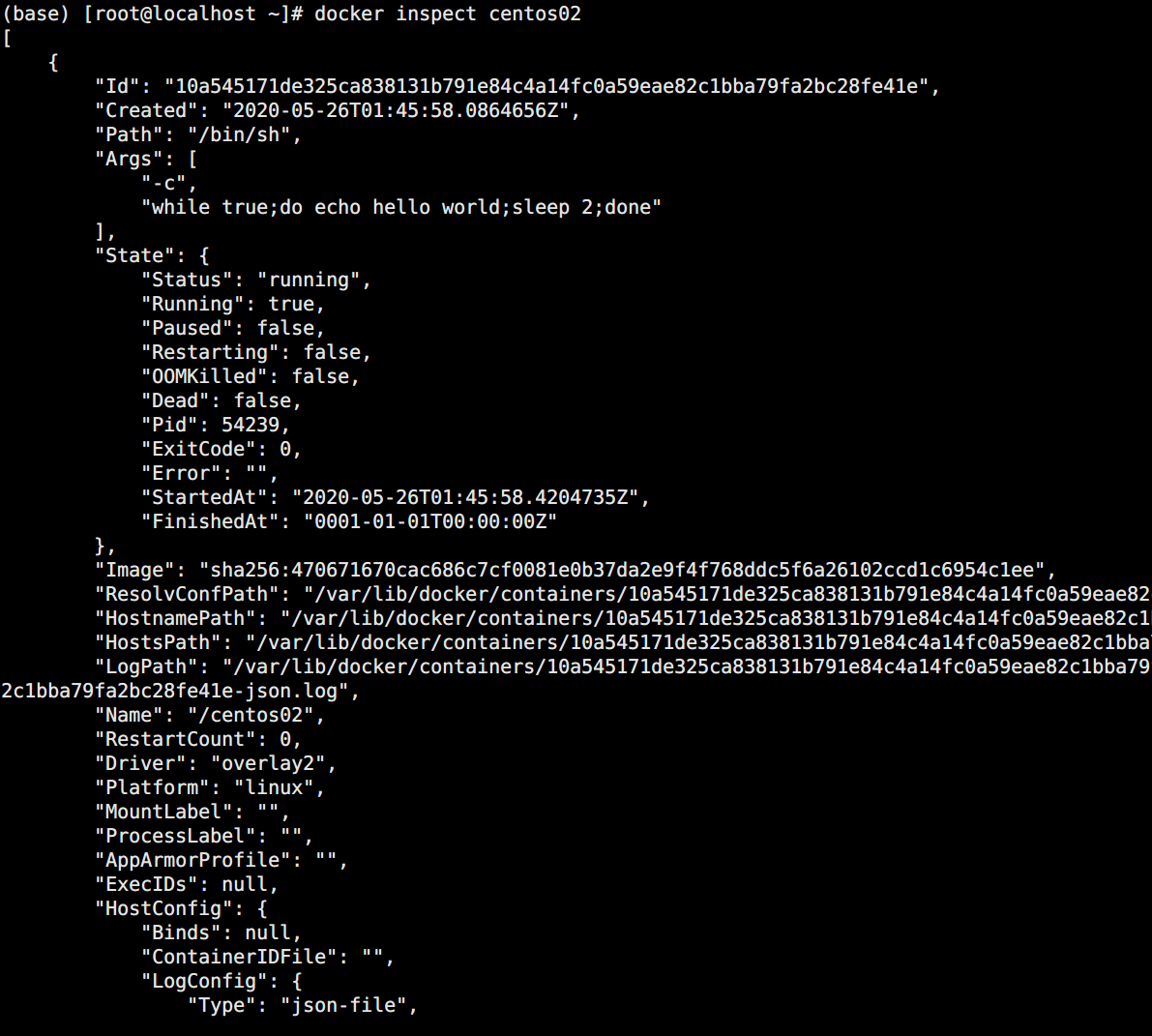
-
进入正在运行的容器并以命令行交互
重新进入正在运行的容器
docker attach 容器ID/容器名
还有一种方式是
docker exec -it 容器ID/容器名 bash(功能更加强大,可以直接返回结果到客户端)区别在于:
-
attach 命令直接进入容器启动命令的终端,不会启动新的进程
-
exec 命令是在容器中打开新的终端,并且可以启动新的进程
- 从容器内拷贝文件到主机上
docker cp 容器ID(或容器名):容器内路径 目的主机路径示例如下

4. 常用命令总结
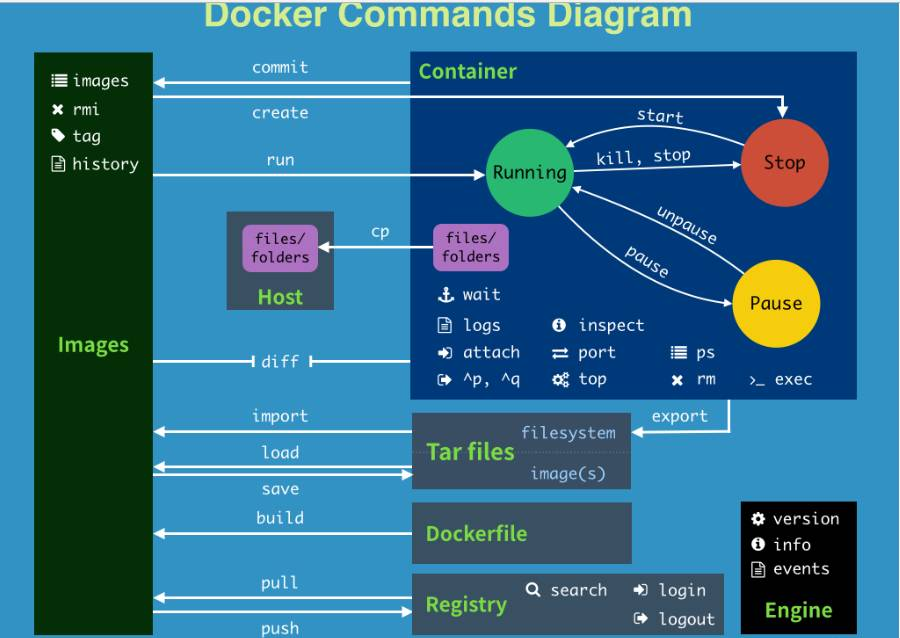
attach Attach to a running container # 当前 shell 下 attach 连接指定运行镜像
build Build an image from a Dockerfile # 通过 Dockerfile 定制镜像
commit Create a new image from a container changes # 提交当前容器为新的镜像
cp Copy files/folders from the containers filesystem to the host path #从容器中拷贝指定文件或者目录到宿主机中
create Create a new container # 创建一个新的容器,同 run,但不启动容器
diff Inspect changes on a container's filesystem # 查看 docker 容器变化
events Get real time events from the server # 从 docker 服务获取容器实时事件
exec Run a command in an existing container # 在已存在的容器上运行命令
export Stream the contents of a container as a tar archive # 导出容器的内容流作为一个 tar 归档文件[对应 import ]
history Show the history of an image # 展示一个镜像形成历史
images List images # 列出系统当前镜像
import Create a new filesystem image from the contents of a tarball # 从tar包中的内容创建一个新的文件系统映像[对应export]
info Display system-wide information # 显示系统相关信息
inspect Return low-level information on a container # 查看容器详细信息
kill Kill a running container # kill 指定 docker 容器
load Load an image from a tar archive # 从一个 tar 包中加载一个镜像[对应 save]
login Register or Login to the docker registry server # 注册或者登陆一个 docker 源服务器
logout Log out from a Docker registry server # 从当前 Docker registry 退出
logs Fetch the logs of a container # 输出当前容器日志信息
port Lookup the public-facing port which is NAT-ed to PRIVATE_PORT # 查看映射端口对应的容器内部源端口
pause Pause all processes within a container # 暂停容器
ps List containers # 列出容器列表
pull Pull an image or a repository from the docker registry server # 从docker镜像源服务器拉取指定镜像或者库镜像
push Push an image or a repository to the docker registry server # 推送指定镜像或者库镜像至docker源服务器
restart Restart a running container # 重启运行的容器
rm Remove one or more containers # 移除一个或者多个容器
rmi Remove one or more images # 移除一个或多个镜像[无容器使用该镜像才可删除,否则需删除相关容器才可继续或 -f 强制删除]
run Run a command in a new container # 创建一个新的容器并运行一个命令
save Save an image to a tar archive # 保存一个镜像为一个 tar 包[对应
load]
search Search for an image on the Docker Hub # 在 docker hub 中搜索镜像
start Start a stopped containers # 启动容器
stop Stop a running containers # 停止容器
tag Tag an image into a repository # 给源中镜像打标签
top Lookup the running processes of a container # 查看容器中运行的进程信息
unpause Unpause a paused container # 取消暂停容器
version Show the docker version information # 查看 docker 版本号
wait Block until a container stops, then print its exit code # 截取容器停止时的退出状态值